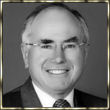

John Howard is the present Prime Minister of Australia. He was born in Earlwood, a Sydney suburb, on July 26, 1930. He attended the local government primary school and later the Canterbury Doys' I Ligh School. After studying law at Sydney University, he graduated in 1961, and then practiced as a solicitor for the next 12 years. A loyal Liberal Party member, he was soon deeply involved in its organization, and he joined the party's New South Wales State Executive in 1963 and continued serving there until his election to the Commonwealth Parliament in March 1974.
In 1971 Howard married Janette Parker, and they have two daughters and two sons. He entered the House of Representatives as Liberal member for the suburban Sydney seat of Bennelong at the general election on May 18, 1974. Howard first became a Minister following the election of the Fraser coalition government in December 1975, taking the Business and Consumer Affair portfolio, which he held until 1977. From May to December 1977 he served as Minister Assisting the Prime Minister and from July as Minister for Special Trade Negotiation. In November that year, a month before the next federal elections, he was appointed Treasurer.
During the 13 years of Labor government that followed, Howard occupied a series of key position in the Shadow ministry. He was Shadow Treasurer and Deputy Liberal Party Leader from 1983-1985 before replacing Andrew Peacook as Opposition Leader on September 1985. Howard led the Liberal Country Party coalition to a narrow loss at the next federal elections in July 1987. From 1989 to 1995 Howard was filling a series of Shadow Ministry portfolios and other Opposition positions; Shadow Minister for Industry, Technology and Communication, Shadow Minister Assisting the Leader on the Public Service, Chairman of the Manpower and Labor Market Reform Group, Shadow Minister for Industrial Relations and Manager of Opposition Business in the House. Under his revitalized leadership, the Opposition coalition began campaigning on the promise of drastically reducing the Commonwealth's increasingly heavy debt burden.
At the next federal elections, on March 02 1996, the Liberal National Party coalition under Howard was swept back into power with a huge House of Representatives majority. Howard led the Liberal Country Party coalition to a landslide electoral victory on March 02 1996, ending Labor's 13 years in office; the longest period the coalition had ever sat in Opposition.
Among the most widely disputed of the Howard government's actions during its first term in office, was its plans for introducing a tax on consumption - its proposed goods and services tax or 'GST.' Popular rejection of the 'GST' had been a key factor in the Liberal-National Party electoral loss in March 1993; but Howard and his Treasurer confidently entered the elections for a second term in office with the 'GST' as central plank in their platform. Despite the traditional of the new tax proposals, the government comfortably won the elections on October 10, 1998. Supported by the Australian Democrats, who had demanded modification of the GST Bills, the government succeeded in persuading the Senate to accept GST legislation in June 1999. Howard saw the Senate's approval of the legislation as the greatest triumph of his 25-year parliamentary career.
As Howard's government grew more confident, foreign affairs and immigration became areas in which its performance increasingly came under inspection. Its attitude towards events such as the arrival of many beatleads of illegal immigrants, communal violence in Indonesia and Malaysia, the independence of East Timor, the continuing warfare in the Balkans following the collapse of the former Communist state of Yugoslavia, and attempt to find peaceful solution to the troubles of Northern Ireland, attracted great attention in the news media.
Another matter for lively public and parliamentary debate throughout Howard's Prime Ministership has been the question of Australia's dispensing with the monarchy and becoming republic. Although Howard is personally an avowed monarchist, he came to office promising to establish a broad-based constitutional convention to debate issues relevant to the creation of an Australian republic
When Howard became Prime Minister, he successfully promoted nation-wide gun control legislation and began the sale of Telstra: the nation's telecommunications carrier. Changes were made to industrial relations, tax and indigenous land rights legislation. Government expenditure was reduced to curb public debt, and in 1998 a convention was hold to debate the possibility of a transition to an Australian republic.
All Rights Reserved.